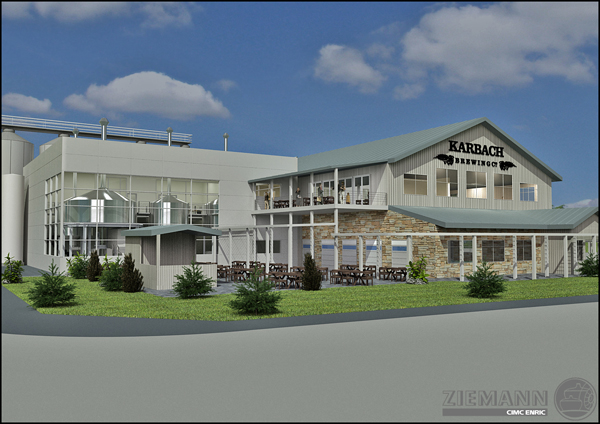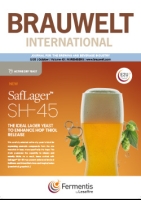The foregoing sections gave a listing in tabular form of about 270 different fermented beverages produced worldwide. In addition to information about raw materials used, the countries in which they are produced as well as fermentation parameters such as time and temperature were listed. In this section of the series, an example is given of how such data can be used, also for market research purposes.
In the first part of this publication (BRAUWELT International no. 1, 2014, pp. 45-48), thermodynamic interrelationships of evaporation in a continuous vaporisation process were presented. Results of an investigation into the evaporation characteristics of various wort aroma substances during a continuous vaporisation process, published in this second part, were obtained with a Boreas counter-flow unit from Krones AG. Investigations were carried out with conventional beer wort and with model solutions. These model solutions were prepared by dissolving the aroma substances listed in table 1 of Part 1 in water in order to be able to illustrate the influence exerted by the viscosity of the liquid in a direct comparison.
Fermentation is one of the oldest methods used purposefully in food processing and beverage production. In the processes, components undergo a material conversion by microorganisms or enzymes so that products are formed that have an influence on stability, aroma and/or tannin content and that are oftentimes regarded as having physiological properties.
An article entitled “New stage for classical brewing art”, published in BRAUWELT no. 45, 2012, pp. 1333-1334, reported on an innovative brewhouse concept. Meanwhile, the Karmeliten Brauerei in Straubing has implemented these ideas in its new brewhouse for the first time. These innovative products will now be presented in a series of articles and the gained practical experience will be summarized accordingly. Part 3 of this series describes the internal boiler Shark.
GEA Brewery Systems recently announced the sale of a Craft-Star brewhouse to The Bruery in Orange County, California. The brewery is specialized in experimental and barrel aged beer and is well on their way to becoming a significant player on the national craft beer scene.
Karbach Brewing Company is the first US craft brewer who decided in favor of a turnkey brewhouse from Ziemann International GmbH, Ludwigsburg. As part of the capacity expansion of the brewery, Ziemann will also install a tank farm consisting of six fermentation and storage tanks.
In modern brewing technology, evaporation during wort boiling is less a matter of adjusting original gravity but, together with hop isomerization and protein precipitation, of removing undesirable aroma substances to a level lower than the sensory threshold. In commercial operations, apart from very widely used atmospheric boiling, a combination of hot holding and evaporation or boiling under pressure or vacuum, together with post-evaporative systems, is frequently used. These additional evaporators are often in the form of a vacuum unit or a stripping process after removal of hot break. Stripping usually takes place as a continuous process where a gas stream serves to vaporize the liquid and, consequently, to desorb a certain portion of the aroma components contained therein.
An article entitled “New stage for classical brewing art”, published in BRAUWELT no. 45, 2012, pp. 1333-1334, reported on an innovative brewhouse concept. Meanwhile, the Karmeliten Brauerei in Straubing has implemented these ideas in its new brewhouse for the first time. These innovative products will now be presented in a series of articles and the gained practical experience will be summarized accordingly. Part 2 of this series describes the lauter tun Lotus.
Rich stock | Fermentation is one of the oldest methods used purposefully in food processing and beverage production. In the processes, components undergo a material conversion by microorganisms or enzymes such that products are formed that have an influence on stability, aroma and/or tannin content and that are oftentimes regarded as having physiological properties.
Rich stock | Fermentation is one of the oldest methods used purposefully in food processing and beverage production. In the processes, components undergo a material conversion by microorganisms or enzymes so that metabolites are formed that have an influence on stability, aroma and/or tannin content and that are oftentimes regarded as having physiological properties. In this four-part contribution, you will find beverages – arranged neatly in accordance with the raw materials used – whose recipes nowadays form the basis for the creative spirit of beverage technologists. The data can also be used, if required, for market research. This will be shown at the end by an example.
The aroma profile of a beer depends on many factors. The majority of valuable aroma components are formed by yeast during fermentation. Unfortunately, the significance of yeast is frequently underestimated and it is oftentimes seen only as a “means to an end”. Selection of the yeast strain plays an important part in formation of esters, higher alcohols and other aroma components, in particular for top-fermenting beers. Every yeast strain has a particular genome and, thus, different modes of aroma synthesis. In order to be able to assess the anticipated aroma profile of a wheat beer, different wheat beer yeast strains were tested under standardised conditions to determine their fermentation characteristics and formation of aroma substances at the Research Center Weihenstephan for Brewing and Food Quality.




